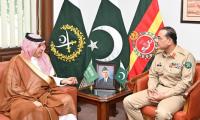The Indian “Cold Start” doctrine has been around for more than a decade. According to a former US ambassador to India, “The Indian Army's Cold Start Doctrine is a mixture of myth and reality. It has never been and may never be put to use on a battlefield because of substantial and serious resource constraints, but it is a developed operational attack plan announced in 2004 and intended to be taken off the shelf and implemented within a 72-hour period during a crisis. Cold Start is not a plan for a comprehensive invasion and occupation of Pakistan. Instead, it calls for a rapid, time- and distance-limited penetration into Pakistani territory…. It was announced by the BJP-led government in 2004, but the government of Prime Minister Manmohan Singh has not publicly embraced Cold Start and GOI uncertainty over Pakistani nuclear restraint may inhibit future implementation by any government.” Even many Indian defence analysts, who maintain cool heads, are not convinced of it being a practical doctrine.
It should be understood by all that a limited war or the Cold Start Doctrine in the Subcontinent poses a serious risk of escalation and intensification due to several factors that may race out of the control of policy makers or military leaders initiating the conflict in the first place and thus could have awful consequences. Observers have already warned that any conventional conflict between India and Pakistan like the Cold Start could quickly spiral out of control and lead towards a nuclear confrontation.
Cold Start has consistently failed to meet its lofty objectives as an assessment of war games conducted in the past seven years by India’s military as well as organizational developments within the service suggest.
There are a whole range of crucial questions about the uninitiated political leaders in New Delhi who, without understanding the doctrine, its deadly ramifications and without sensible precautions, could employ force in a future conflict as the Indian Army tries to modernize and the Indian establishment remains on a perpetual arms buying spree. Instead of achieving a quick decision against Pakistan, the use of the Cold Start could end with potentially catastrophic results and radical reversal in fortunes.
Then there is the question of stability-instability paradox that the Cold Start would generate; the more Indian leaders work into a frenzy and push for a quick military adventure against Pakistan, the more it lowers Pakistan’s nuclear threshold, thus creating further instability, precipitating destruction and defeating the very purpose of a limited war. There could be nothing left to acclaim their triumph in New Delhi.
Meanwhile, according to knowledgeable sources Pakistan is ready to counter the Cold Start by developing her own New Concept of War Fighting (NCWF). The country has addressed both modes, conventional and nuclear in the NCWF. Since the Cold Start was more in cognitive domain and aimed at psychologically putting pressure on the Pakistani leadership, the NCWF has blunted it in both physical and psychological domains and taken the sting out of it.
Observers also believe that the changing dynamics in South and West Asia, unmistakable change of emphasis and Pakistan’s ability to get China and Russia on board for stability in the region have neutralised the US-Indian efforts to pressurise Pakistan anymore.
Saad was of the view that the battle of politics should be fought solely through political means
KP govt decided to develop gemstone business as a formal export sector and cluster at the Namak Mandi would be...
Khyber Pakhtunkhwa Minister for Higher Education, Archives, and Libraries, Meena Khan Afridi. — APP FilePESHAWAR:...
Vehicles and horse carts passing through flood water at Bara Bazar area on Khuwani bridge after heavy rain in Peshawar...
Amid the failure to revive the cash-bleeding PIA, government is left with no other option but to sell it to any...
Picture showing the Silver Jubilee Gate of the University of Karachi. — APP File KARACHI: The University of Karachi...







